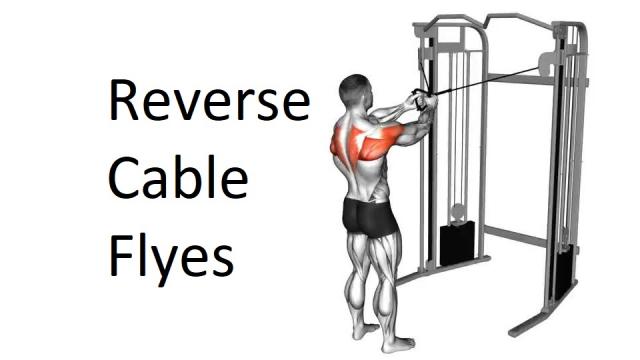Reverse Cable Flyes are a strength training exercise that primarily targets the rear deltoids, helping to strengthen and develop the muscles of the upper back and shoulders. In this comprehensive guide, we’ll explore the correct technique, benefits, variations, and other essential details associated with Reverse Cable Flyes.
Instructions
Setup:
- Cable Machine Setup: Begin by setting up a cable machine with the pulleys positioned at shoulder height. Attach D-handle attachments to both sides of the cable machine.
- Adjust Weight: Select an appropriate weight on the cable machine that allows you to perform the exercise with proper form and control.
Execution:
- Starting Position: Stand in the middle of the cable machine, facing away from the machine. Grasp the D-handles with an overhand grip, palms facing backward, and arms extended straight in front of you.
- Movement: Keeping a slight bend in your elbows, exhale as you pull the handles apart and back, squeezing your shoulder blades together. Imagine trying to touch your elbows behind your back.
- Peak Contraction: Pause for a moment at the peak of the movement when your arms are fully extended to the sides and in line with your shoulders. Focus on engaging your rear deltoids and upper back muscles.
- Return: Inhale as you slowly return to the starting position, allowing the handles to come back together in front of you. Maintain control throughout the movement.
- Repeat: Perform the desired number of repetitions with proper form and control.
Tips:
- Keep your chest lifted and your back straight throughout the exercise to maintain proper posture.
- Focus on using the muscles of your upper back and rear deltoids to initiate and control the movement.
- Avoid using momentum or excessive weight to prevent strain on the shoulder joints.
Benefits
- Rear Deltoid Development: Reverse Cable Flyes primarily target the rear deltoid muscles, helping to strengthen and develop the muscles of the upper back and shoulders.
- Improved Posture: Strengthening the muscles of the upper back can help improve posture and reduce the risk of shoulder injuries by balancing out the muscles that often become weakened from poor posture.
- Shoulder Stability: Reverse Cable Flyes help improve shoulder stability by strengthening the muscles responsible for retracting and stabilizing the shoulder blades.
- Enhanced Shoulder Functionality: By targeting the rear deltoids and upper back muscles, Reverse Cable Flyes can improve shoulder functionality and range of motion, leading to better performance in various upper body exercises and activities.
Muscles worked in Reverse Cable Flyes
Reverse cable flyes primarily target the rear deltoid muscles, which are located on the back of the shoulders. Additionally, this exercise engages several other muscles to provide stabilization and support throughout the movement. Here are the main muscles worked during reverse cable flyes:
- Rear Deltoids: The rear deltoid muscles are the primary movers in reverse cable flyes. They are responsible for shoulder extension and horizontal abduction, meaning they help pull the arms backward and away from the body.
- Rhomboids: The rhomboid muscles, including the rhomboid major and rhomboid minor, are located between the shoulder blades and help retract and stabilize the scapulae (shoulder blades) during the movement.
- Trapezius: The middle and lower fibers of the trapezius muscles assist in retracting the scapulae and stabilizing the shoulders during reverse cable flyes.
- Posterior Deltoids: While the rear deltoids are the primary focus, the posterior deltoids, located on the back of the shoulders, also contribute to the movement to some extent.
- Rotator Cuff Muscles: The muscles of the rotator cuff, including the infraspinatus and teres minor, help stabilize the shoulder joint during the movement to prevent injury and maintain proper form.
- Erector Spinae: The erector spinae muscles, located along the spine, help stabilize the torso and maintain proper posture throughout the exercise.
Overall, reverse cable flyes effectively target the rear deltoid muscles while also engaging several other muscles of the upper back, shoulders, and core to provide stability and support during the movement.
Alternate names for Reverse Cable Flyes:
- Reverse Cable Fly
- Cable Reverse Fly
- Cable Rear Delt Fly
- Cable Reverse Delt Raise
Variations
- Single-Arm Reverse Cable Flyes: Perform the exercise one arm at a time to focus on each side independently and address muscle imbalances.
- Face Pulls: Use a rope attachment and perform a similar movement, pulling the rope towards your face to target the rear deltoids and upper back muscles.
- Seated Reverse Cable Flyes: Perform the exercise while seated on a bench or chair to isolate the muscles of the upper back and rear deltoids further.
- High-to-Low Reverse Cable Flyes: Adjust the pulleys on the cable machine to a higher position and perform the exercise with a downward pulling motion to target the upper back and rear deltoids from a different angle.
Conclusion
Incorporating Reverse Cable Flyes into your workout routine can help strengthen and develop the muscles of the upper back and shoulders, improving posture, shoulder stability, and overall upper body function. By mastering the correct technique and exploring variations, you can maximize the benefits of this effective exercise.

